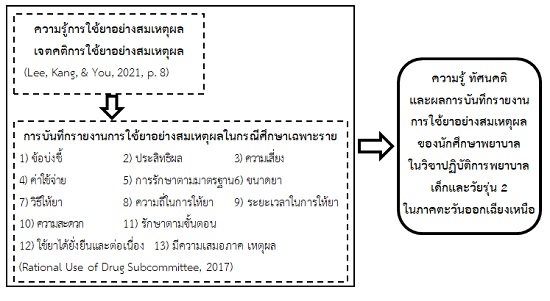KNOWLEDGE, ATTITUDE AND RESULTS RECORDING REPORT OF RATIONAL DRUGS USED OF NURSING STUDENTS IN PEDIATRIC AND ADOLESCENT NURSING PRACTICUM II: CASE STUDY AT A NURSING COLLEGE IN THE NORTHEASTERN
DOI:
https://doi.org/10.14456/nrru-rdi.2023.9Keywords:
Rational drugs used, Knowledge of drugs used, Attitudes of drugs used, Results recording report of drugs usedAbstract
The purpose of this research was to study knowledge, attitudes and results recording report of rational drugs used (RDU), and to examine the correlations among knowledge, attitudes and results recording report between RDU in pediatric and adolescent nursing practicum II. There were 77 participants with third-year nursing students in this study by a purposive selection. A questionnaire was separated into three parts: knowledge of RDU, attitudes of RDU, and results recording report of RDU in case study. A validity tested IOC of knowledge questionnaire range was 0.72-1.00. Reliabilities of knowledge, attitudes, and results recording report parts of RDU were 0.78, 0.74 and 0.76 respectively. Data were collected when participants finished practicing the pediatric and adolescent nursing practicum II. Data were analyzed by using descriptive statistics. In addition, Pearson Correlation Coefficient was used to utilize the correlations between variables. Results showed that participants were at high levels of knowledge ( =18.64, S.D.=1.11), attitudes (
=4.43, S.D.=0.58), and results recording report (
=4.47, S.D.=0.63). The relationships between knowledge and results recording report were a weak positive correlation (r=0.34, p<0.01), knowledge and attitudes was a weak positive correlation (r=0.21, p<0.01), and attitudes and results recording report was a weak with negative correlation (r= -0.13, p<0.01).
References
Best, J. W. (1977). Research in Education. New Jersey : Prentice Hall Inc.
Bloom, S. J. (1975). Taxonomy of education objective. In hand book1: cognitive domain. New York : David Mckay.
Boromarajonani College of Nursing Khon Kaen. (2021). List of Bachelor of Nursing students Academic Year 2020 (revised Feb. 21). Retrieved December 12, 2020, from https://drive.google.com/file/d/1IGGFAJXpwfGl9ciMDBp9M465yZs3oeiA/view (In Thai)
Bunmusik, S., Chantra, R., & Heeaksorn, C. (2018). Knowledge Attitude and Behaviors in Rational Antibiotics Use of Nursing Students Southern College of Nursing and Public Health Network. Journal of Health Research and Innovation, 2(1), 26-35. (In Thai)
Cengiz, Z., & Ozkan, M. (2021). Development and validation of a tool to assess the rational use of drugs in Turkish adults. Journal of Public Health, 29, 719-724. https://doi.org/10.1007/s10389-020-01251-w
Chankunapas, P., Boonyarit, P., Srisupan, W., Leungruaengrong, P., & Prapaso, N. (2016). Service Plan: Rational Drug Use. Nontaburi : Public Sector Development Group, Health Administration Division, Office of the Permanent Secretary Ministry of Public Health. (In Thai)
El-Sokkary, R., Kishk, R., Mohy El-Din, S., Nemr, N., Mahrous, N., Alfishawy, M., ... & Tash, R. (2021). Antibiotic use and resistance among prescribers: Current status of knowledge, attitude, and practice in Egypt. Infection and drug resistance, 1209-1218.
Hayat, K., Jamshed, S., Rosenthal, M., Haq, N. U., Chang, J., Rasool, M. F., ... & Fang, Y. (2021). Understanding of pharmacy students towards antibiotic use, antibiotic resistance and antibiotic stewardship programs: a cross-sectional study from Punjab, Pakistan. Antibiotics, 10(1), 66. https://doi.org/10.3390/antibiotics10010066
Hinkle, D. E. (1998). Applied Statistics for the Behavioral Sciences. Boston : Houghton Mifflin.
Jitthrum, W. (2018). Pediatric and Neonatal resuscitation. Department of Pediatrics. Phitsanulok : Faculty of Medicine, Naresuan University. (In Thai)
Khan, Z., Karatas, Y., Martins, M. A. P., Jamshed, S., & Rahman, H. (2022). Knowledge, attitude, practice and barriers towards pharmacovigilance and adverse drug reactions reporting among healthcare professionals in Turkey: a systematic review. Current medical research and opinion, 38(1), 145-154. https://doi.org/10.3390/antibiotics10121462
Lee, M., Kang, B. A., & You, M. (2021). Knowledge, attitudes, and practices (KAP) toward COVID-19: a cross-sectional study in South Korea. BMC public health, 21, 1-10. https://doi.org/10.1186/s12889-021-10285-y
National Drug System Development committee. (2011). National Drug Policy A.D 2010 and National Drug System Development Strategy A.D 2011-2015. Nonthaburi : Aksorn Graphic and Design Publication Limited Partnership. (In Thai)
Ozatik, F. Y., Babaoglu, U. T., Ozkaraman, A., Yigitaslan, S., & Erol, K. (2019). The Knowledge and Attitude of Nursing Students Towards Rational Drug use. Osmangazi Journal of Medicinem, 41(4), 315-325.
Petchroj, L., & Chumniprasart, A. (2019). Research Methodology. Bangkok : Chareandeemunkong printing. (In Thai)
Priyatruk, P., Wittayasooporn, J., & Theinpichet, S. (2018). Guide to Reasonable Drug Use in Nursing Curriculum. Bangkok : Danex corporation limited. (In Thai)
Putthikhan, P., Suwannapong, K., Angsirisak, N., Turner, K., & Theinpichet, S. (2019). An Evaluation of the Policy of Integrating RDU Curriculum into the Bachelor of Nursing Science Program and RDU Competency of Nurse Instructors. Thai Red Cross Nursing Journal, 13(1), 282-301. (In Thai)
Rational Use of Drug Subcommittee. (2017). Teacher’s Guide for Promoting Rational Drug Use. Nonthaburi : Aksorn Graphic and Design Publication Limited Partnership. (In Thai)
Sannathimmappa, M. B., Nambiar, V., & Aravindakshan, R. (2021). A cross-sectional study to evaluate the knowledge and attitude of medical students concerning antibiotic usage and antimicrobial resistance. International Journal of Academic Medicine, 7(2), 113-119. DOI:10.4103/IJAM.IJAM_57_20
Sornkrasetrin, A., Rungnoei, N., Thongma, N., Klinchat, R., Rajataramya, B., & Nitirat, P. (2018). Factors Predicting the Rational Antibiotic Use among Nursing Students. The Journal of Baromarajonani College of Nusing, Nakhonratchasima, 25(1), 43-59. (In Thai)
Srisathitnarakul, B. (2010). The Methodology in Nursing Research. Bangkok : U & I Intermedia limited. (In Thai)
Student, D. B. A. P., & Buyukbayram, Z. (2021). The Effect of Rational Drug Use on Health Perception and Drug Compliance in Chronic Diseases. International Journal of Caring Sciences, 14(1), 497-506.
Subcommittee on National Key Drug Development. (2009). Guide to Reasonable Drug Use According to the National Drug List (Thai National Formulary 2008). Bangkok : Thailand Agricultural Cooperative Printing Press. (In Thai)
Zimbardo, P. G., Ebbesen, E. O., & Maslash, C. (1977). Influencing attitude and changing behavior (2nd ed.). California : Addison-Wesly publishing company.

Downloads
Published
How to Cite
Issue
Section
License

This work is licensed under a Creative Commons Attribution-NonCommercial-NoDerivatives 4.0 International License.



